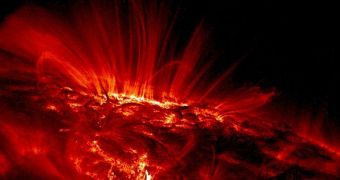The surface of the Sun is not perfectly uniform. When researchers first discovered sunspots, they saw the structure as dark, magnetic blemishes on the solar surface. Since then, explaining how the spots form has been a challenge, despite numerous attempts. A new theory is now being proposed.
One of the most widely-accepted theories on sunspot formation is that the flow of heat is prevented from reaching a certain portion of the solar surface by a sharp increase in magnetic activity. This boost is only temporary.
However, this explanation only transfers the issue to the source of those magnetism boosts, and does not provide a clear understanding of the root cause of sunspots. The latest idea suggests that the formation of hydrogen molecules may play a role in these processes.
Experts at the University of Hawaii in Manoa say that the chemical reaction is causing a pressure drop underneath regions of the solar surface, which then start to allow magnetic fields to come together and intensify, before starting to block heat from reaching the surface.
Solar scientist Sarah Jaeggli conducted the research when she was studying at UHM. The investigator explains that about 90 percent of the solar mass is accounted for by hydrogen, whereas helium makes up a little less than 10 percent. All other chemicals only make up 0.13 percent of the solar mass.
“The formation of a large fraction of molecules may have important effects on the thermodynamic properties of the solar atmosphere and the physics of sunspots,” adds the team leader, quoted by Space.
UHM investigator Haosheng Lin and National Solar Observatory expert Han Uitenbroek were also a part of the research team. The group conducted the investigations using the Dunn Solar Telescope, in Sunspot, New Mexico.
“We found evidence that significant quantities of hydrogen molecules form in sunspots that are able to maintain magnetic fields stronger than 2,500 Gauss,” Jaeggli explains, adding that our planet only develops a one-half Gauss magnetic field.

 14 DAY TRIAL //
14 DAY TRIAL //